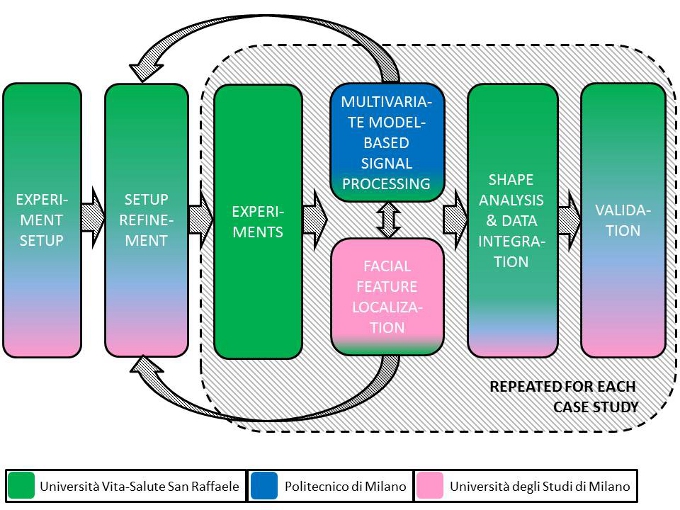All the units will be involved in the setup and refinement of the experiment.
Careful parameter setting, sample selection and well defined inclusion/exclusion criteria will increase the chances of extracting useful information from the data. A well planned experiment will provide a reliable basis for multivariate modeling, which will guarantee stable and robust models.
The common location (Milan) of all participants of the project represents clearly a big advantage for the setup of a real interdisciplinary research team.
Experimental session will be entirely carried out by USR unit, only clinicians/psychologists will deal with patients.
Once data (in this case images, self-reported questionnaires and expert judgements of psychologists) have been collected, UniMi unit will start with facial feature location and expression detection while PoliMi unit will be involved in linear and non-linear analysis and modeling of biomedical signals.
In this phase, interaction between UniMi and PoliMi units will be helpful to (pre)select features of interest and to communicate and check project progresses.
Then USR unit, will tackle the following tasks:
- statistical shape analysis: use geometric morphometric to extract features of the face (namely, landmark and semilandmark points) and to classify the expressions in specific types of emotions (depending on the application), in a promising way;
- Bayesian modeling for data integration: integrate, in the previous statistical model, personal and clinical data of the patient, his physiological signals and other expert knowledge information, to improve the accuracy of the classification.
As concerning the Bayesian modeling issue, the collaboration with the other units and with the psychologists will be essential for the definition and formalization of our prior information. As known, these models allow also to include prior information (either estimated on previous datasets or given by experts/domain knowledge) in order to estimate the parameters avoiding the overfitting. For example, quantitative knowledge can be used to set constrains on the parameters, while qualitative knowledge to model their relations. Finally, all the units will be involved again in the validation phase.
